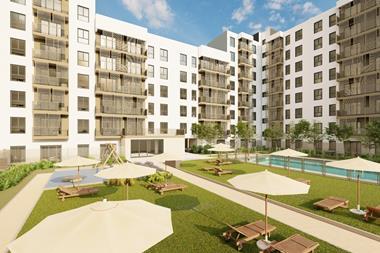Institutional investors are now locked out of London’s residential sector, according to the Investment Property Databank (IPD)’s annual index.
The wider UK sector, which last year produced a total 13.5% return, is at a crossroads, delegates heard at MSCI’s presentation of its IPD residential property index today.
The index tracks the performance of 6,685 property investments with a £3.5bn (€4.8bn) capital value.
Record low yields for London residential property investment have turned institutional investors towards the private rented sector (PRS), as potential first-time buyers also struggle to invest.
Yields in central London are now below 2%, IPD data showed.
Mark Weedon, vice-president and head of alternatives at MSCI, said there was now a “de facto exclusion” on central London for most institutional investors, at a time when concern over access to housing has “seldom been higher”.
In the week that the UK’s prime minister announced plans to build 200,000 homes by 2020, investors in the country’s residential sector were grappling with more immediate concerns.
“If you are looking to put money into the sector now, our data shows that investors seeking income will find themselves priced out by foreign investors and owner occupiers when trying to buy existing stock in London,” Weedon said.
However, limited investment opportunities in PRS are making life difficult for investors.
Speaking on a panel at IPD’s presentation in central London, Ed Crockett, director of residential funds at Aberdeen Asset Management, said the company was looking at PRS development opportunities, but that there was very little stock.
The investment manager, he said, recently made a “big, income-producing acquisition” in the UK, having last year announced plans to invest as much as £500m in UK PRS.
The advantages of investing in developments outshine investment in existing assets, Crockett added.
He estimated that as much as 82% of the UK’s existing PRS is more than 25 years old.
“Self-developed residential is a lower risk than commercial,” Crockett said. “As it’s designed for purpose and brand new, that means there’s lower capital expenditure.”
While development of PRS now seems to be the only option and London is over-priced, Hermes Real Estate is looking beyond the UK capital, its head of strategy, Nigel Roberts, told delegates.
Roberts said its UK PRS fund, expected to produce a 7% return, will invest beyond the UK capital, with a 75% weighting to UK regions.
Hermes, the investment manager owned by the BT Pension Scheme, last year launched the fund with estate agency Countrywide, seeded with £95m.
“The PRS sector is supported by a shift towards urban living and offers a favourable supply and demand balance,” Roberts said.
“UK regional cities are resurgent with new infrastructure and new powers.”
Weedon said it was “no surprise” investors were now considering building to let.
In a survey of the 200 delegates gathered at today’s presentation, half expected residential investment to return between 5% and 10% this year, with similar consensus for the next three years.
A separate study of the UK residential sector by Invesco Real Estate said UK PRS offered “attractive opportunities” for institutional investors.
The investment manager estimates that the UK PRS sector is worth £990bn.
The firm’s report said £2.5bn was invested in UK PRS last year as demand for rental property increases.
“PRS has sufficient scale, transparency and return profiles to be of interest to institutional investors,” Invesco said.








